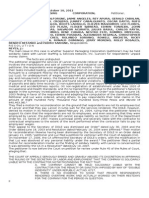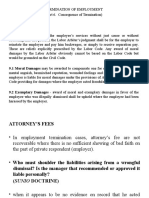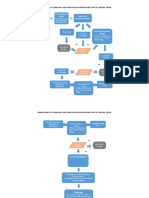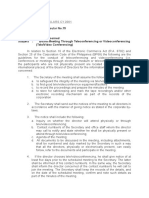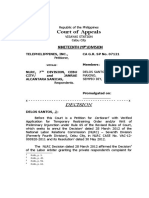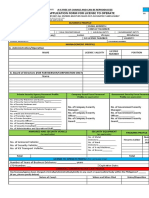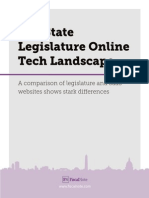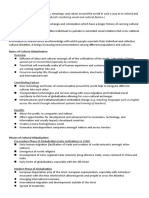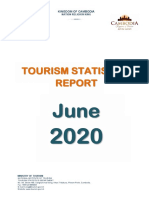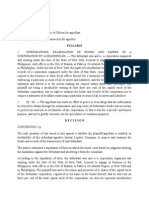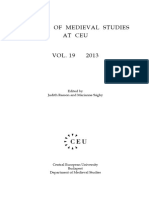0 ratings0% found this document useful (0 votes)
502 viewsState of Emergency Leave Memo
State of Emergency Leave Memo
Uploaded by
Jon OrtizThis memorandum from the California Department of Human Resources provides guidance to state agencies on administrative time off (ATO) for employees affected by the state of emergency declared in response to the 2014 South Napa Earthquake. It allows up to 5 days of paid ATO for employees who work or live in affected counties and meet certain criteria, such as having their workplace closed or being unable to safely travel to work. Agencies can approve up to 30 days total of ATO. Employees not directly affected but volunteering in disaster response may also receive ATO. The memorandum outlines eligibility criteria and procedures for approving additional ATO beyond 5 days.
Copyright:
© All Rights Reserved
Available Formats
Download as PDF, TXT or read online from Scribd
State of Emergency Leave Memo
State of Emergency Leave Memo
Uploaded by
Jon Ortiz0 ratings0% found this document useful (0 votes)
502 views2 pagesThis memorandum from the California Department of Human Resources provides guidance to state agencies on administrative time off (ATO) for employees affected by the state of emergency declared in response to the 2014 South Napa Earthquake. It allows up to 5 days of paid ATO for employees who work or live in affected counties and meet certain criteria, such as having their workplace closed or being unable to safely travel to work. Agencies can approve up to 30 days total of ATO. Employees not directly affected but volunteering in disaster response may also receive ATO. The memorandum outlines eligibility criteria and procedures for approving additional ATO beyond 5 days.
Original Description:
PML 2014-021
Original Title
State of Emergency leave memo
Copyright
© © All Rights Reserved
Available Formats
PDF, TXT or read online from Scribd
Share this document
Did you find this document useful?
Is this content inappropriate?
This memorandum from the California Department of Human Resources provides guidance to state agencies on administrative time off (ATO) for employees affected by the state of emergency declared in response to the 2014 South Napa Earthquake. It allows up to 5 days of paid ATO for employees who work or live in affected counties and meet certain criteria, such as having their workplace closed or being unable to safely travel to work. Agencies can approve up to 30 days total of ATO. Employees not directly affected but volunteering in disaster response may also receive ATO. The memorandum outlines eligibility criteria and procedures for approving additional ATO beyond 5 days.
Copyright:
© All Rights Reserved
Available Formats
Download as PDF, TXT or read online from Scribd
Download as pdf or txt
0 ratings0% found this document useful (0 votes)
502 views2 pagesState of Emergency Leave Memo
State of Emergency Leave Memo
Uploaded by
Jon OrtizThis memorandum from the California Department of Human Resources provides guidance to state agencies on administrative time off (ATO) for employees affected by the state of emergency declared in response to the 2014 South Napa Earthquake. It allows up to 5 days of paid ATO for employees who work or live in affected counties and meet certain criteria, such as having their workplace closed or being unable to safely travel to work. Agencies can approve up to 30 days total of ATO. Employees not directly affected but volunteering in disaster response may also receive ATO. The memorandum outlines eligibility criteria and procedures for approving additional ATO beyond 5 days.
Copyright:
© All Rights Reserved
Available Formats
Download as PDF, TXT or read online from Scribd
Download as pdf or txt
You are on page 1of 2
STATE OF CALIFORNIA
Department of Human Resources
Memorandum
TO: Personnel Management Liaisons (PML)
SUBJECT:
Administrative Time Off During State of Emergency
REFERENCE NUMBER:
2014-021
DATE ISSUED:
08/25/14
SUPERSEDES:
This memorandum should be forwarded to:
Personnel Officers
Personnel Transactions Supervisors
Employee Relations Officers
FROM: Department of Human Resources
Labor Relations Division
CONTACT: Personnel Services Branch
(916) 323-3343
Fax: (916) 322-0765
Email: psb@calhr.ca.gov
Governor Edmund G. Brown Jr. declared a state of emergency on August 24, 2014 for the
counties of Napa, Solano and Sonoma due to the effect of the 6.1 magnitude South Napa
Earthquake. This earthquake and continued aftershocks have damaged critical infrastructure,
homes, other structures, caused fires and the closure of roads and highways.
This memo is being released as a reminder to state agencies that California Code of
Regulations (CCR) 599.785.5 allows for up to five (5) days of Administrative Time Off (ATO)
during a Governor declared state of emergency for those employees that meet the provisions of
the rule. In addition to the five (5) days of ATO authorized by the rule, the California
Department of Human Resources (CalHR) delegated to departments the ability to approve ATO
for up to a total of 30 calendar days (PML 2007-026).
For those areas that have not been declared a state of emergency, to the extent it is
operationally feasible, appointing powers should grant employees requests to use their leave
credits due to the current effects of the South Napa Earthquake.
The CCR 599.785.5 allows for ATO during a state of emergency as outlined below.
(a) Employees may be granted a paid leave of absence of up to five days by their appointing
power when the employee works or resides in a county where a state of emergency has been
proclaimed by the Governor and the appointing power determines that at least one of the
following conditions exist:
(1) The employee's normal place of business is closed temporarily, during the employee's
normal work shift, due to the effects of the emergency.
(2) The emergency effectively precludes the employee's ability to find reasonable routes of
transportation from the employee's normal residence to the work place.
(3) The emergency presents an immediate and grave peril to the employee's own safety, that of
an employee's immediate family member, or the employee's principal residence.
PML 2014-021
August 25, 2014
Page 2
STATE OF CALIFORNIA
(4) The employee is actively involved in a formal, organized effort to protect the health and
safety of the general public; such as, the employee is a member of the auxiliary fire or police
department or the employee is asked by local authorities to assist with sandbagging efforts.
(5) The employee needs to take time off to apply for disaster assistance from the Federal
Emergency Management Agency (FEMA) because the employee is unable to apply for
assistance before or after the employee's normal work shift.
(b) An employee may be granted a paid leave of absence up to five days by the employee's
appointing power regardless of the location of the disaster when the employee is preregistered
with, and providing volunteer service to, a State agency carrying out its responsibilities under
the Governor's Executive Order D-25-83. The employees providing volunteer service are
required to notify their appointing power of their affiliation with the volunteer services and to
establish prior arrangements regarding the notification of the appointing power in the event the
employee is asked to participate in the State disaster response. The appointing power shall
release the employee to provide volunteer service when an emergency occurs unless there is a
critical departmental operating reason to prevent such a release.
(c) No paid leave of absence shall exceed five working days without the prior approval of the
appointing power and the prior approval of the Department of Human Resources. The
Department of Human Resources shall grant approval of a paid leave of absence in excess of
five working days based on its finding that one of the criteria above continues to be met.
(d) State employees called into service as specified in Government Code 19844.5 are excluded
from the above standards.
For questions related to this PML, state department personnel office designated liaisons should
contact CalHRs Personnel Services Branch by emailing questions to psb@calhr.ca.gov or
calling (916) 323-3343.
/s/Mary Sue Paul
Mary Sue Paul, Manager
Personnel Services Branch
You might also like
- Standard Employment Contract For Filipino Household Service WorkersDocument2 pagesStandard Employment Contract For Filipino Household Service WorkersRaymond WongNo ratings yet
- Human Rights Complete NotesDocument17 pagesHuman Rights Complete Notesmikayz30100% (7)
- Example Reference Request Letter and Pro-FormaDocument2 pagesExample Reference Request Letter and Pro-FormaMohsin Raza MaitlaNo ratings yet
- OWMSDocument43 pagesOWMSJosephine Jagorin100% (1)
- 14 Training Costs AgreementDocument2 pages14 Training Costs AgreementJohna Mae Dolar EtangNo ratings yet
- Sample Letter To Employee On LeaveDocument2 pagesSample Letter To Employee On LeaveScience ReviewNo ratings yet
- Application For Authority To Bear Firearms With Affidavit of UndertakingDocument3 pagesApplication For Authority To Bear Firearms With Affidavit of UndertakingGreg TrinidadNo ratings yet
- Aep Cancellation NCR 2024Document2 pagesAep Cancellation NCR 2024msctravelconsultNo ratings yet
- Re Notice To ExplainDocument8 pagesRe Notice To ExplainMonsterFish MNL (MonsterFishMNL)No ratings yet
- Advisory-LADY LOCAL LEGISLATORS' LEAGUE OF THE PHILIPPINES, INC. (FOUR-L) REGIONAL AND PROVINCIAL ELECTIONDocument4 pagesAdvisory-LADY LOCAL LEGISLATORS' LEAGUE OF THE PHILIPPINES, INC. (FOUR-L) REGIONAL AND PROVINCIAL ELECTIONBienvenido TamondongNo ratings yet
- Nanat Demand LetterDocument1 pageNanat Demand LetterAthena SalasNo ratings yet
- Omnibus Sworn Statement (Multi-B)Document2 pagesOmnibus Sworn Statement (Multi-B)Danica Irish RevillaNo ratings yet
- PAGCOR Personal Disclosure Statement FormDocument4 pagesPAGCOR Personal Disclosure Statement FormPennyConsunji100% (1)
- Notice of TerminationDocument1 pageNotice of TerminationPaula LandigNo ratings yet
- Revision of 1st Specialized ManCom Meeting Minutes - KNRP SignedDocument12 pagesRevision of 1st Specialized ManCom Meeting Minutes - KNRP SignedkeziahNo ratings yet
- List of Pre-Employment Requirements RevDocument1 pageList of Pre-Employment Requirements RevJessica MelitanteNo ratings yet
- Set 2 Labor Law CasesDocument155 pagesSet 2 Labor Law CasesMary Queen Ramos-UmoquitNo ratings yet
- Annex A: Be Added)Document5 pagesAnnex A: Be Added)Irah kabilingNo ratings yet
- President and CEO: Ramon Cojuangco Building Makati Ave., Makati City, PhilippinesDocument2 pagesPresident and CEO: Ramon Cojuangco Building Makati Ave., Makati City, PhilippinesRai Ly LifeNo ratings yet
- Affidavit of Loss: IN WITNESS WHEREOF, I Have Hereunto Set My Hands This 1st Day of July 2019 atDocument1 pageAffidavit of Loss: IN WITNESS WHEREOF, I Have Hereunto Set My Hands This 1st Day of July 2019 atJheyps VillarosaNo ratings yet
- Memorandum On Guidelines and Procedures On Claims For Overtime PayDocument6 pagesMemorandum On Guidelines and Procedures On Claims For Overtime PayJoel C. RiveraNo ratings yet
- 13 New Moa Between The Ro and Its Partner Agency Re Gip ImplementationDocument5 pages13 New Moa Between The Ro and Its Partner Agency Re Gip ImplementationDan MarkNo ratings yet
- Application Form: Republic of The PhilippinesDocument5 pagesApplication Form: Republic of The Philippinesmary ann carreonNo ratings yet
- Special Power of Attorney:, Nameof Representative, Nameof Representative Postition BranchDocument1 pageSpecial Power of Attorney:, Nameof Representative, Nameof Representative Postition Branchaira alyssa caballeroNo ratings yet
- RrcatacutanDocument1 pageRrcatacutanShiean Dello100% (1)
- NOTICE OF AWARDS (For Works Contracts) : Kalahi-Cidss National Community Driven Development ProgramDocument1 pageNOTICE OF AWARDS (For Works Contracts) : Kalahi-Cidss National Community Driven Development ProgramBdak B. IbiasNo ratings yet
- Primer On The Regionalization Program: College of Medicine University of The Philippines ManilaDocument28 pagesPrimer On The Regionalization Program: College of Medicine University of The Philippines ManilaKristel Keith NievaNo ratings yet
- Termination NoticeDocument1 pageTermination NoticeHans NisaNo ratings yet
- Affidavit of Loss (Passbook)Document1 pageAffidavit of Loss (Passbook)Cyril Ann IriberriNo ratings yet
- BLANK Addendum To The ContractDocument2 pagesBLANK Addendum To The Contractconnie byrdNo ratings yet
- Ot Form SampleDocument1 pageOt Form SampleNetforceInternational HRNo ratings yet
- Secretary's CertificateDocument1 pageSecretary's CertificateJerald Peter VargasNo ratings yet
- Order To Close - D'spot PharmacyDocument2 pagesOrder To Close - D'spot PharmacyCharmila SiplonNo ratings yet
- RCL Agri-Ventures: MinutesDocument2 pagesRCL Agri-Ventures: MinutesAnna Liza GamaoNo ratings yet
- Calaex - Drainage Sub ContractDocument6 pagesCalaex - Drainage Sub ContractMhonn Bulanguit PadillaNo ratings yet
- Vendor Consent FormDocument5 pagesVendor Consent Formmj.catalan.mjcNo ratings yet
- Labrel ReportDocument14 pagesLabrel ReportJenieNo ratings yet
- SERVICE AGREEMENT - Tree Cutting ServiceDocument11 pagesSERVICE AGREEMENT - Tree Cutting ServiceEllaine D RamirezNo ratings yet
- BizLink Manual - PhilHealth 2Document11 pagesBizLink Manual - PhilHealth 2Janella MarieNo ratings yet
- Acnowledgement Receipt For ClientDocument1 pageAcnowledgement Receipt For ClientPatrio Jr SeñeresNo ratings yet
- Social Security SystemDocument21 pagesSocial Security SystemJhoana Parica FranciscoNo ratings yet
- Complaint Filed: Administrative Complaint and Investigation Procedure For The Central OfficeDocument4 pagesComplaint Filed: Administrative Complaint and Investigation Procedure For The Central OfficeAngeline ChavesNo ratings yet
- Letter of AuthorizationDocument1 pageLetter of AuthorizationLindsay MillsNo ratings yet
- ObliCon Cases Fortuitous EventDocument41 pagesObliCon Cases Fortuitous EventReyzen Paul Unite MendiolaNo ratings yet
- Board Meeting Through Teleconference - MEMORANDUM CIRCULARS CY 2001Document2 pagesBoard Meeting Through Teleconference - MEMORANDUM CIRCULARS CY 2001Chil BelgiraNo ratings yet
- Notice To Terminate EmploymentDocument1 pageNotice To Terminate EmploymentClang SantosNo ratings yet
- Contract of Probationary EmploymentDocument4 pagesContract of Probationary EmploymentDv AccountingNo ratings yet
- DPRM Form Esd 03 A Revised 2017Document2 pagesDPRM Form Esd 03 A Revised 2017ericson almerez100% (1)
- Pro-Forma Application Letter For Enrollment in PEZA Electronic Zone Transfer System (EZTS)Document2 pagesPro-Forma Application Letter For Enrollment in PEZA Electronic Zone Transfer System (EZTS)PortCallsNo ratings yet
- Sample MemorandumDocument3 pagesSample MemorandumJohnNo ratings yet
- GRABTAXI Letter Request (Interview)Document2 pagesGRABTAXI Letter Request (Interview)Togz MapeNo ratings yet
- Letter of CondolenceDocument1 pageLetter of CondolenceKyle Watson0% (1)
- 2023 Legal Opinion MOA With LCDFIDocument1 page2023 Legal Opinion MOA With LCDFIBrandon DangatagNo ratings yet
- Sarath Resignation LetterDocument1 pageSarath Resignation LetterNithinNo ratings yet
- Dishonesty Suspension2Document120 pagesDishonesty Suspension2Melvin PernezNo ratings yet
- Labor CaseDocument18 pagesLabor CaseJoon Dy0% (1)
- Application Form For License To OperateDocument3 pagesApplication Form For License To OperateAngelo ruel Belen100% (2)
- Bangko Sentral NG PilipinasDocument11 pagesBangko Sentral NG PilipinasLou Nonoi TanNo ratings yet
- Employee Travel WaiverDocument1 pageEmployee Travel WaiverChristine CyNo ratings yet
- Walking a Tightrope: Biography of Honorable Mayor Catalino Gabot Hermosilla Sr.From EverandWalking a Tightrope: Biography of Honorable Mayor Catalino Gabot Hermosilla Sr.No ratings yet
- 2019 Fmla FormDocument8 pages2019 Fmla FormlaurendprussellNo ratings yet
- SEIU 1000 Agenda Packet For June 2016 BOD MeetingDocument24 pagesSEIU 1000 Agenda Packet For June 2016 BOD MeetingJon OrtizNo ratings yet
- California Department of General Services' Real Estate Services Division AuditDocument65 pagesCalifornia Department of General Services' Real Estate Services Division AuditJon OrtizNo ratings yet
- Motion For Preliminary InjunctionDocument17 pagesMotion For Preliminary InjunctionJon OrtizNo ratings yet
- SF Superior Court Order Sustaining DemurrerDocument4 pagesSF Superior Court Order Sustaining DemurrerJon OrtizNo ratings yet
- DMV Call Center Policy Grievance DocumentsDocument26 pagesDMV Call Center Policy Grievance DocumentsJon OrtizNo ratings yet
- Jerome Horton Letter To Carlos RamosDocument2 pagesJerome Horton Letter To Carlos RamosJon OrtizNo ratings yet
- GOP Transportation PlanDocument2 pagesGOP Transportation PlanJon OrtizNo ratings yet
- Jerome Horton Letter To Carlos RamosDocument2 pagesJerome Horton Letter To Carlos RamosJon OrtizNo ratings yet
- Coopers "Second Opinion" Report On CalPERS LTCDocument49 pagesCoopers "Second Opinion" Report On CalPERS LTCJon Ortiz100% (1)
- Improper Activities by State Agencies and EmployeesDocument63 pagesImproper Activities by State Agencies and EmployeesJon OrtizNo ratings yet
- 2015 Government Operations Agency Employee Engagement Survey ReportDocument96 pages2015 Government Operations Agency Employee Engagement Survey ReportJon OrtizNo ratings yet
- Calipatria Incident ReportDocument3 pagesCalipatria Incident ReportJon OrtizNo ratings yet
- FiscalNote Whitepaper On Legislative TechDocument9 pagesFiscalNote Whitepaper On Legislative TechJon OrtizNo ratings yet
- Lobby Employers 1Document118 pagesLobby Employers 1Jon OrtizNo ratings yet
- Cultural GlobalizationDocument4 pagesCultural GlobalizationRay John DulapNo ratings yet
- Human Rights and Humanitarian LawDocument2 pagesHuman Rights and Humanitarian LawShweta BhartiNo ratings yet
- KopenhagenDocument20 pagesKopenhagenŠime Novi Profil NimacNo ratings yet
- Test Centers - Sorted by City Telephone Address Direction SDocument5 pagesTest Centers - Sorted by City Telephone Address Direction Sghali100No ratings yet
- Ilovepdf MergedDocument35 pagesIlovepdf MergedTHE GEOGRAPHERNo ratings yet
- Rotary Peace Center Fact Sheet Makerere enDocument1 pageRotary Peace Center Fact Sheet Makerere enEKNo ratings yet
- Tourism Statistics: Kingdom of CambodiaDocument8 pagesTourism Statistics: Kingdom of CambodiaAubrey LabardaNo ratings yet
- Validate DebtDocument2 pagesValidate DebtJulian Garcia100% (1)
- ME Gray Vs Insular Lumber CompanyDocument3 pagesME Gray Vs Insular Lumber CompanyEl G. Se ChengNo ratings yet
- African Women Under Pre-ColonialDocument9 pagesAfrican Women Under Pre-ColonialAnonymous UGZskpisNo ratings yet
- AgagDocument111 pagesAgagamry_233No ratings yet
- Medieval Queens and Queenship The PreseDocument55 pagesMedieval Queens and Queenship The PreseBoudewijnVCNo ratings yet
- Ckyc Individual FormDocument6 pagesCkyc Individual FormKumardeep MukhopadhyayNo ratings yet
- Aram Ias TNPSC Test ScheduleDocument11 pagesAram Ias TNPSC Test ScheduleMaithiliNo ratings yet
- LetterDocument1 pageLetterJIJESH GOKULDASNo ratings yet
- 162 Con Grecs 6765Document84 pages162 Con Grecs 6765Andrew KaczynskiNo ratings yet
- JointDocument4 pagesJointintermazeNo ratings yet
- 1001 1 PDFDocument10 pages1001 1 PDFShimlaNo ratings yet
- Caste PoliticsDocument10 pagesCaste PoliticssadsamosasNo ratings yet
- IntroductionDocument7 pagesIntroductionjosholiveros664No ratings yet
- RoshiniDocument30 pagesRoshiniapi-269841586No ratings yet
- CRIM PEOPLE Vs ZUELADocument2 pagesCRIM PEOPLE Vs ZUELABug RancherNo ratings yet
- 111105-DIAC Genuine Temporary Entrant CriteriaDocument5 pages111105-DIAC Genuine Temporary Entrant CriteriaPurwanto DwiNo ratings yet
- LEPARTO-YANGZON, Lynn Marie DDocument3 pagesLEPARTO-YANGZON, Lynn Marie DRaphNheyCabantudNo ratings yet
- EDUC 5810 Assignment Unit 2Document5 pagesEDUC 5810 Assignment Unit 2Nhi LeNo ratings yet
- City Government of QC v. Ericta, G.R. No. L-34915, June 24, 1983 (Supra)Document6 pagesCity Government of QC v. Ericta, G.R. No. L-34915, June 24, 1983 (Supra)AkiNiHandiongNo ratings yet
- Political Science MCQs Practice Test 125 PDFDocument6 pagesPolitical Science MCQs Practice Test 125 PDFAalisha PriyaNo ratings yet
- Ssa-795fillable DotDocument2 pagesSsa-795fillable Dotapi-3368796580% (1)
- Essay Writing Competition - QCECDocument3 pagesEssay Writing Competition - QCECDheer chawlaNo ratings yet
















